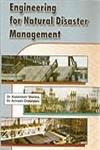Engineering For Natural Disaster Management -Hardcover
Engineering For Natural Disaster Management -Hardcover
Couldn't load pickup availability
This Book will be of immense help to 'all those contemplating to acquire an expert knowledge of engineering techniques for natural disaster management. The determination of seismic risk level involves considerable uncertainty and requires special study and understanding of the phenomena involved. The policy planning regarding mitigation of earthquake risk is not only concerned with the existing risk level but also with what would be the acceptable risk taking into account the trade offs involving cost to the individual, cost to the society, amount of safety increased per unit of additional cost, etc. Seismic micro zonation studies in hazard prone urban areas and damage scenario estimates in severe seismic zones could establish the seismic risk levels to be taken care of by concerted mitigation measures. The risks related to natural disasters specially in the case of earthquakes in an area can be considered to be a function of four components as follows: Seismic Risk = f (Hazard, Exposure, Vulnerability, Location) Hazard means the occurrence of an earthquake of sufficient Magnitude (hence peak Intensity at the epicenter) capable of causing damage to the man-made structures. Exposure indicates the objects and structures built by man which are exposed to the effects of the 'hazard' and will include buildings, bridges, dams, power plant, lifeline structures, equipment's, building contents etc.
Share

